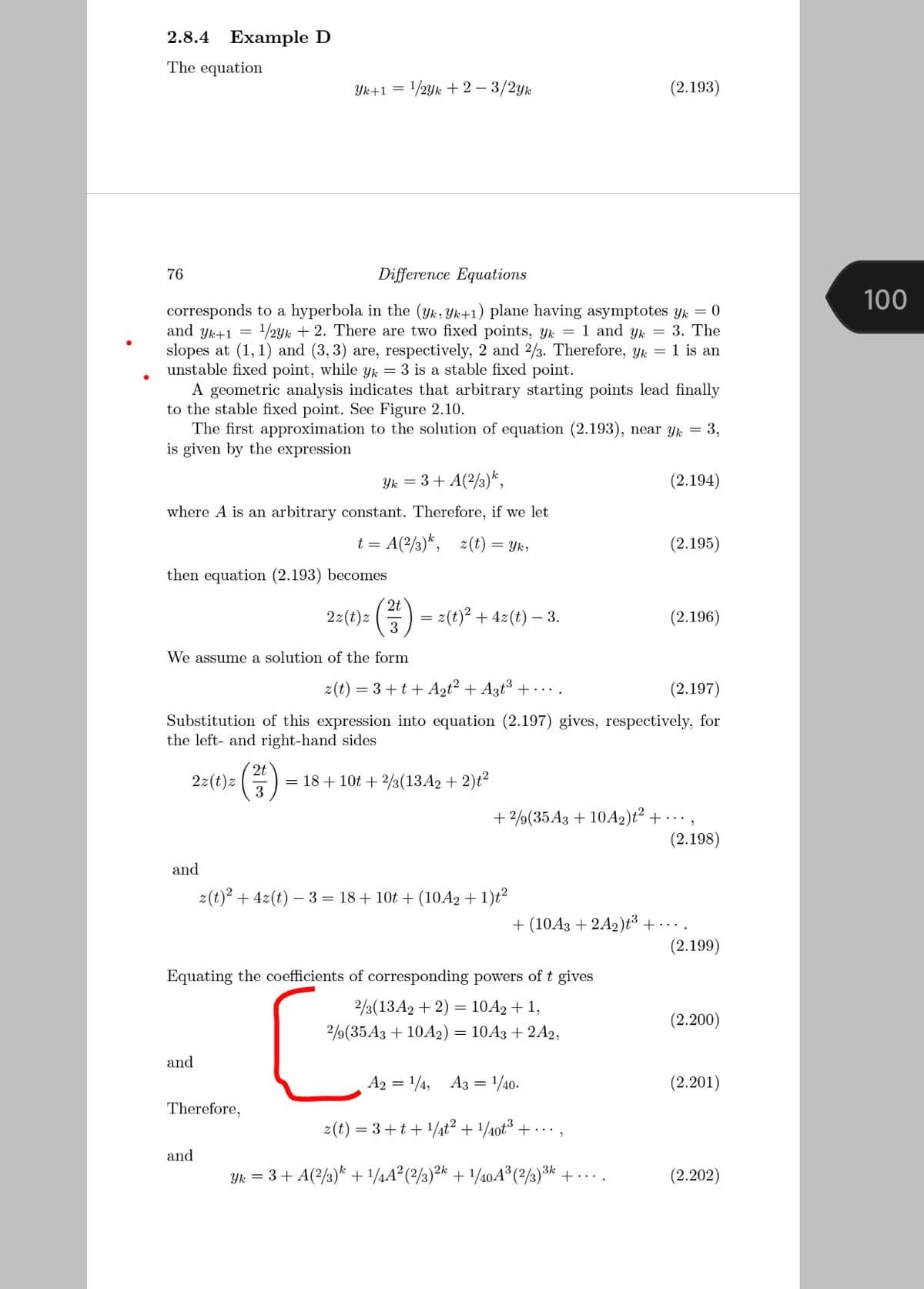Equating the coefficients of corresponding powers of t gives 2/3(13A2 + 2) = 10A2 + 1, (2.200) 2/9(35A3 + 10A2) = 10A3 + 2A2, and A2 = 1/4, A3 = 1/40. (2.201) Therefore, z(t) = 3+t+ 1/at² + 1/4ot3 + ..,
Equating the coefficients of corresponding powers of t gives 2/3(13A2 + 2) = 10A2 + 1, (2.200) 2/9(35A3 + 10A2) = 10A3 + 2A2, and A2 = 1/4, A3 = 1/40. (2.201) Therefore, z(t) = 3+t+ 1/at² + 1/4ot3 + ..,
Algebra & Trigonometry with Analytic Geometry
13th Edition
ISBN:9781133382119
Author:Swokowski
Publisher:Swokowski
Chapter11: Topics From Analytic Geometry
Section: Chapter Questions
Problem 22RE
Related questions
Concept explainers
Equations and Inequations
Equations and inequalities describe the relationship between two mathematical expressions.
Linear Functions
A linear function can just be a constant, or it can be the constant multiplied with the variable like x or y. If the variables are of the form, x2, x1/2 or y2 it is not linear. The exponent over the variables should always be 1.
Question
100%
Solve the detemaine equation step by step

Transcribed Image Text:2.8.4 Example D
The equation
Yk+1 =
1/29k + 2 – 3/2yk
(2.193)
76
Difference Equations
100
corresponds to a hyperbola in the (yk, Yk+1) plane having asymptotes yk = 0
and yk+1 =
slopes at (1, 1) and (3, 3) are, respectively, 2 and 2/3. Therefore, yk = 1 is an
unstable fixed point, while y = 3 is a stable fixed point.
A geometric analysis indicates that arbitrary starting points lead finally
to the stable fixed point. See Figure 2.10.
The first approximation to the solution of equation (2.193), near yk = 3,
is given by the expression
1/2Yk + 2. There are two fixed points, Yk = 1 and yk = 3. The
Yk = 3+ A(?/3)*,
(2.194)
where A is an arbitrary constant. Therefore, if we let
t = A(2/3)*, z(t) = Yk,
(2.195)
t%3D
then equation (2.193) becomes
2t
2:(0): )
2(t)² + 4z(t) –
(2.196)
- 3.
3
We assume a solution of the form
2(t) = 3+t+ A2t² + A3t³ + • . ..
(2.197)
Substitution of this expression into equation (2.197) gives, respectively, for
the left- and right-hand sides
2t
2z(t)z
= 18 + 10t + 2/3(13A2 + 2)t²
3
+ 2/9(35A3 + 10A2)t² + · · · ,
(2.198)
and
z(t)? + 4z(t) – 3 = 18+ 10t + (10A2 +1)t²
+ (10A3 + 2A2)t³ + · · · .
(2.199)
Equating the coefficients of corresponding powers of t gives
2/3(13A2 + 2) = 10A2 + 1,
(2.200)
2/0(35A3 + 10A2) = 10A3 + 2A2,
and
A2 = 1/4, A3 = '/40.
(2.201)
Therefore,
z(t) = 3+t+ 1/4t2 + 1/40t + ·..,
and
Yk = 3+ A(2/3)* + 1¼A² (?/3)²k + 1/40A³ (?/3)³k + • . . .
(2.202)
Expert Solution
This question has been solved!
Explore an expertly crafted, step-by-step solution for a thorough understanding of key concepts.
Step by step
Solved in 2 steps

Knowledge Booster
Learn more about
Need a deep-dive on the concept behind this application? Look no further. Learn more about this topic, calculus and related others by exploring similar questions and additional content below.Recommended textbooks for you

Algebra & Trigonometry with Analytic Geometry
Algebra
ISBN:
9781133382119
Author:
Swokowski
Publisher:
Cengage

Algebra & Trigonometry with Analytic Geometry
Algebra
ISBN:
9781133382119
Author:
Swokowski
Publisher:
Cengage